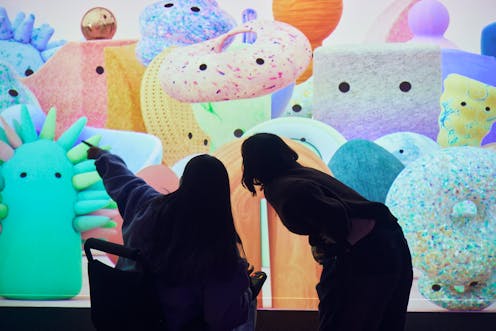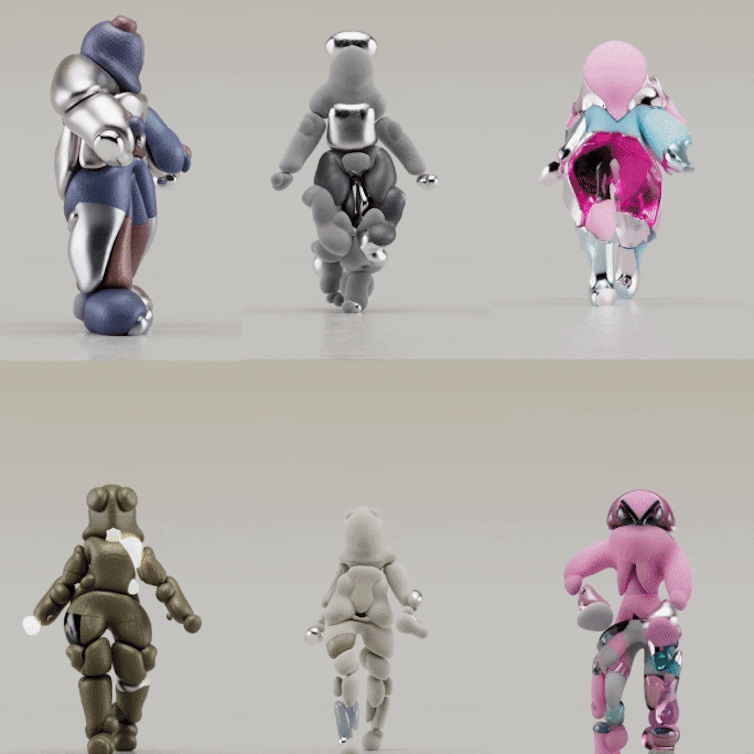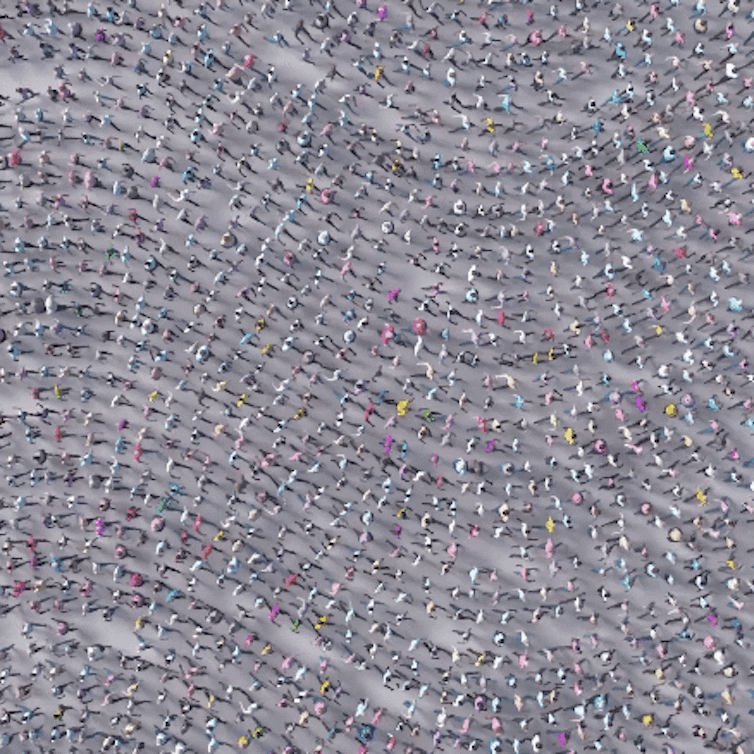
At this week’s launch of Beings by Universal Everything, ACMI board member Ian Forsyth noted that ACMI’s last exhibition, Marshmallow Laser Feast: Works of Nature, exceeded audience targets by 40–50%. This is an enormous success by any measure. It proves ACMI’s vision for its premiere exhibition space is working.
Exhibitions like Beings and Marshmallow Laser Feast are designed as fun-for-the-whole-family experiences. This assumption was supported by the reference to kindness as the core of creativity by Universal Everything collective member Joel Gethin Lewis, who spoke at the launch. Lewis went on to conjure the late anthropologist and activist David Graeber with the assertion that play and care were the only two sustainable activities developed by the human race.
Let me say at the outset, kids will probably love it. It looks like the distilled essence of Pixar’s Monster’s Inc visual appeal. Essence is the wrong word though; to be honest this is more like pastiche.
In the end, Beings is yet another example of spectacle being substituted for substance at great expense.
Beings and nothingness
Upon our arrival we are greeted by variously “skinned” bobbing 3D lumps. Skins are textures that wrap a 3D object like wood grain, dots, freckles etc. The bouncing forms of these lumps, reminiscent of the rubber hose period of American animation, occupy a white void, which appears to flow directly and seamlessly off the room’s architecture.
The effect is of a digital trompe l’oeil accompanied by melodic snippets of voice that cycle in rounds to create a looping crowd noise. It’s reminiscent of the hypnotically polyphonous music of the Aka Pygmies.
Moving on, we encounter a passing parade of what look like virtual soundsuits by the visual artist Nick Cave. Technically, what we have is the recording of human movement transposed onto polymorphous 3D figures in various skins.

Various points on the figures’ bodies are extruded into hair or tentacles, with virtual gravity and inertia acting on them to give them bounce and drag. But this is Drag minus the transgression. Drag and the carnivalesque are premised on the usurping of norms and the social moirés of the everyday, but this work hollows out these important traditions.
Just as these 3D models have no interior, so, too, this work seems all surface; it is an effect at the service of nothing.
In the next room along we are greeted by a much larger curving screen, which once again features the motif of the parade. One can’t help but think of voguing and Mardi Gras, but there is no life here. Granted, the real-time rendering is incredible: computer power and programming have come a long way. However, technology and indeed technique must be at the service of something.

What we have here is the Muppets minus the spicy lurking threat of the monstrous.
The third room contains a milling crowd, a murmuration of men seen from above. Once again, I had the distinct impression of a lack of direction. The exhibition lacked the overarching skill of a writer, animateur, choreographer or director to put all this breathtaking tech at the service of something other than a generic cuteness.

Seeing a dancer in the subsequent space I felt the thrill of just such a possibility. My ideal version of the exhibition could certainly have been fulfilled by putting these walk cycles at the service of a choreographer (as in Chunky Move’s Mortal Engine of 2008). But this was one moment of transcendence for technology that was otherwise left soaking in its own demo loops.
Adjacent to the dancer was a vertical screen populated by hyper-feminised, hip-rolling robots, possibly riffing on Phoebe Waller-Bridge’s turn as L3-37 in the movie Solo. But these lacked Waller-Bridge’s arch sass, let alone the thrill of Lee Bowery, of which they also seemed a pale echo.
Who is it for?
As I have said, this show is one for the kids and they will probably love it, including the interactive dimensions that allow their movement to be skinned by various fantastic creatures in real time.
And, if it wasn’t clear to those invited to the launch that they were not the target audience, it was reinforced by Ian Forsyth’s stated distinction between “real people living in suburbs” and those present for the launch. Such a classist distinction is yet another example of the anti-intellectual tradition in Australia (yawn).

But I am also troubled by this apparently either/or choice being made for a world-class institution. ACMI’s curatorial drive for broad appeal overlooks the possibility that the culture of cute can be critical and appealing.
In Beings we experience an automated (albeit virtuosic) system that reduces the explosive creative exuberance of camp and drag to an algorithm. In the process it becomes vacuous, despite its psychedelically cheerful enthusiasm.
Beings is at ACMI, Melbourne, until September 29.
Dominic Redfern does not work for, consult, own shares in or receive funding from any company or organisation that would benefit from this article, and has disclosed no relevant affiliations beyond their academic appointment.
This article was originally published on The Conversation. Read the original article.







